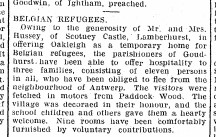As refugees from Belgium poured into England in the autumn of 1914 – many of whom arrived at the Kentish ports of Dover and Folkestone – the towns and villages of West Kent swung into action, offering shelter, raising money, collecting household items, and providing medical care to the wounded. The local press reported a range of initiatives by local authorities and voluntary groups alike.
In Maidstone – as in Tunbridge Wells – the council announced that unoccupied properties which were used to house refugees would be exempt from rates. The local teachers’ association raised money to provide a house and concerts were held to raise money, for example at the Wesleyan church. In late September a party of refugees from Louvain arrived (via Antwerp and Alexandra Palace) and were housed at the Kent Adult School Union Guesthouse in Barming, a village just outside the county town.
Village dwellers were every bit as involved as townsfolk. In Marden the parish council organized a house-to-house collection which raised over £100 for the Belgian Relief Fund. Similarly in East Peckham the whole village was asked to contribute (though in this village there seems to have been two committees: a general one and another run by the Salvation Army). In Pembury a whist drive was organized in aid of the Relief Fund. As refugees arrived in the villages they were often greeted by enthusiastic crowds, as in the case of Lamberhurst.

Source: South East Gazette, 3 November 1914
Some of the Belgian arrivals into the county were wounded soldiers in need of medical treatment. It was reported that there were 2500 wounded men at Folkestone who had to be found places to recover in. Among the venues West Kent venues where they quickly received help were Hayle Place, a mansion near Maidstone, and the Tonbridge School sanatorium. In addition, twenty of the injured were sent to Hawkhurst.

Source: Private Collection
The Kent and Sussex Courier carried a vivid account of the arrival of a group of wounded Belgian soldiers at Paddock Wood in October 1914. The Red Cross Voluntary Aid Detachment commandant, Dr Crawford of Pembury, was asked to make provision for some of the wounded men so he took over the parochial hall at Paddock Wood. Aided by the local builder and undertaker, Mr Penn, and four of his men to act as stretcher-bearers, and some ‘working women’ who scrubbed the hall floor, Dr Crawford had the hall ready by 8am the next morning when the soldiers were due to arrive at the station. Crowds of people turned out to greet the men. The Courier reported that:
The scene of the arrival of the wounded soldiers was one that will not soon be forgotten in Paddock Wood… It was not long before every one of the heroes was snugly ensconced in his little camp bed.
Gradually, most of the wounded recovered and the nature of the help that refugees required changed. On 21st May 1915 the Courier reported that the last of the wounded Belgians had left the VAD hospital which had been set up in Pembury. Some soldiers returned to the army, while others moved elsewhere to work. An example is Andre Vandeneynde, a Belgian soldier who was registered as residing in Pembury in December 1914. Andre took up munitions work and moved first to Tonbridge (where he married a young woman from Paddock Wood in 1916) and later to Letchworth, where he worked for the Belgian-run firm, Kryn and Lahy.
The rest of the refugees also had to find some form of support. Some, for example, a young lady, also residing in Pembury, advertised for private pupils to teach them French. However, the charitable efforts of the people of West Kent remained important. In December 1915 Tunbridge Wells’ women’s suffrage society claimed that its clothing depot had helped refugees as far afield as Folkestone and even Holland, as well as in nearby villages such as Pembury and Frant.
Locally as well as nationally, the amount of press attention to the refugees decreased as the war went on. However, the evidence from the early months of the war suggests that the towns and villages of West Kent made noticeable efforts to deal with the crisis and that there cannot have been many settlements – however small – that did not do something to help.
Sources:
Belgian National Archives, Brussels.
South East Gazette, 3 November 1914, 10 November 1914, 14 November 1914.
Kent Messenger, 26 September 1914, 10 October 1914.
Kent and Sussex Courier, 16 October 1914, 18 December 1914, 21 May 1915, 28 May 1915, 10 December 1915.
